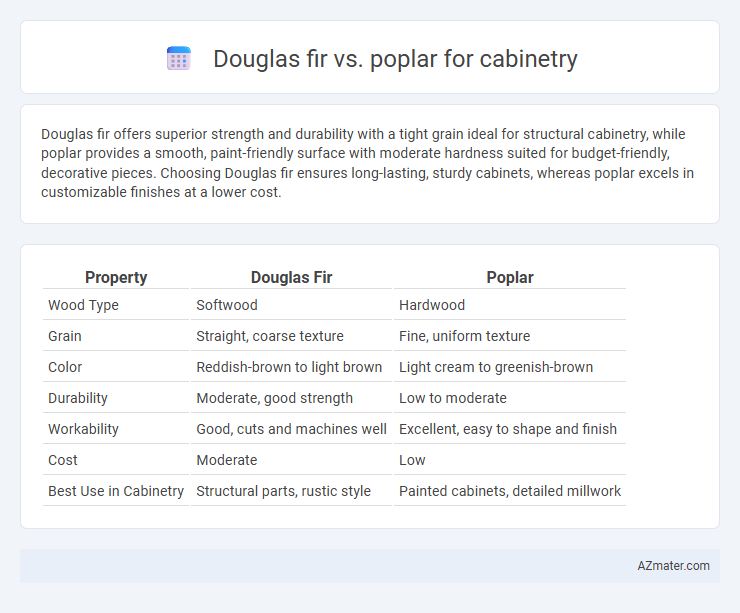Douglas fir offers superior strength and durability with a tight grain ideal for structural cabinetry, while poplar provides a smooth, paint-friendly surface with moderate hardness suited for budget-friendly, decorative pieces. Choosing Douglas fir ensures long-lasting, sturdy cabinets, whereas poplar excels in customizable finishes at a lower cost.
Table of Comparison
| Property | Douglas Fir | Poplar |
|---|---|---|
| Wood Type | Softwood | Hardwood |
| Grain | Straight, coarse texture | Fine, uniform texture |
| Color | Reddish-brown to light brown | Light cream to greenish-brown |
| Durability | Moderate, good strength | Low to moderate |
| Workability | Good, cuts and machines well | Excellent, easy to shape and finish |
| Cost | Moderate | Low |
| Best Use in Cabinetry | Structural parts, rustic style | Painted cabinets, detailed millwork |
Introduction to Douglas Fir and Poplar for Cabinetry
Douglas fir offers superior strength and a rich, warm grain, making it a popular choice for durable and visually appealing cabinetry. Poplar features a smooth texture and pale color, allowing for easy staining and customization in various cabinetry styles. Both woods provide versatile options, with Douglas fir excelling in toughness and Poplar favored for its cost-effectiveness and ease of finishing.
Wood Characteristics: Douglas Fir vs. Poplar
Douglas fir features a tight, straight grain with a reddish-brown hue, providing strong durability and resistance to wear, ideal for sturdy cabinetry. Poplar, characterized by its softer texture and light cream to greenish tones, is easier to work with and paints well but is less dense, making it prone to dents. Choosing between Douglas fir and poplar for cabinetry depends on the need for strength and natural grain visibility versus ease of finishing and cost-effectiveness.
Strength and Durability Comparison
Douglas fir offers superior strength and durability compared to poplar, making it more suitable for cabinetry that requires long-lasting structural integrity. With a Janka hardness rating of 660, Douglas fir resists dents and wear better than poplar, which has a lower rating of around 540. Poplar is softer and more prone to dents and scratches, limiting its use in high-traffic or heavy-use cabinetry.
Workability and Machinability
Douglas fir offers excellent workability with a straight grain and moderate hardness, making it easy to cut, shape, and join with standard woodworking tools. Poplar is highly machinable due to its uniform texture and softness, allowing for smooth milling, carving, and finishing, but it may bruise or dent more easily during handling. Both woods respond well to staining and painting, though Douglas fir's resinous properties can require extra preparation to achieve a smooth finish.
Appearance and Grain Differences
Douglas fir features a reddish-brown color with a straight, pronounced grain pattern that provides a rustic and warm appearance ideal for traditional cabinetry. Poplar exhibits a lighter, creamy to greenish hue with a fine, uniform grain, offering a smooth, modern look suitable for painted or stained finishes. The contrasting grain intensity and color between Douglas fir and poplar influence their aesthetic appeal, with fir emphasizing texture and warmth, while poplar prioritizes subtlety and versatility.
Cost and Availability
Douglas fir offers moderate cost and widespread availability, making it a practical choice for cabinetry projects seeking durability and a warm grain pattern. Poplar is generally more affordable but less commonly stocked in some regions, which can affect lead times and sourcing ease for cabinet makers. Both woods are versatile, yet balancing budget constraints with local supply often guides the final selection for cabinetry construction.
Finishing Options and Paintability
Douglas fir offers excellent finishing options due to its fine, straight grain and natural reddish-brown color, which accepts stains and clear finishes evenly, enhancing its warm aesthetic. Poplar is highly regarded for its superior paintability because of its smooth, uniform texture and light, neutral color, making it an ideal choice for vibrant, opaque paint finishes without grain interference. Both woods provide versatile options, but poplar is preferred when a flawless painted surface is desired, while Douglas fir is favored for rich stained finishes that showcase natural wood character.
Environmental Impact and Sustainability
Douglas fir offers superior sustainability for cabinetry due to its rapid growth rate and lower environmental impact from harvesting, as it is commonly sourced from managed forests with replanting practices. Poplar, while also renewable, often involves higher transportation emissions because it is less widely grown in sustainable forestry operations. Opting for Douglas fir supports reduced carbon footprints and better forest ecosystem management in cabinetry production.
Best Applications in Cabinetry
Douglas fir's strong grain patterns and durability make it ideal for structural cabinetry components and rustic-style cabinet frames, delivering superior strength in load-bearing applications. Poplar's fine, uniform texture and ease of painting suit it best for cabinet doors, drawer fronts, and painted finishes, providing a smooth surface for detailed millwork. Choosing Douglas fir enhances cabinetry longevity in high-stress areas, while poplar excels in customizable aesthetics and intricate designs.
Douglas Fir vs. Poplar: Which is Right for Your Project?
Douglas Fir offers exceptional strength, durability, and a tight, straight grain that resists warping, making it ideal for cabinetry exposed to heavy use and structural stress. Poplar is softer and more affordable, with a fine, even texture that takes paint well but lacks the hardness and natural resistance of Douglas Fir. Choosing between Douglas Fir and Poplar depends on whether you prioritize long-term durability and a natural wood look or cost-effectiveness and ease of finishing in your cabinetry project.

Infographic: Douglas fir vs Poplar for Cabinetry
 azmater.com
azmater.com